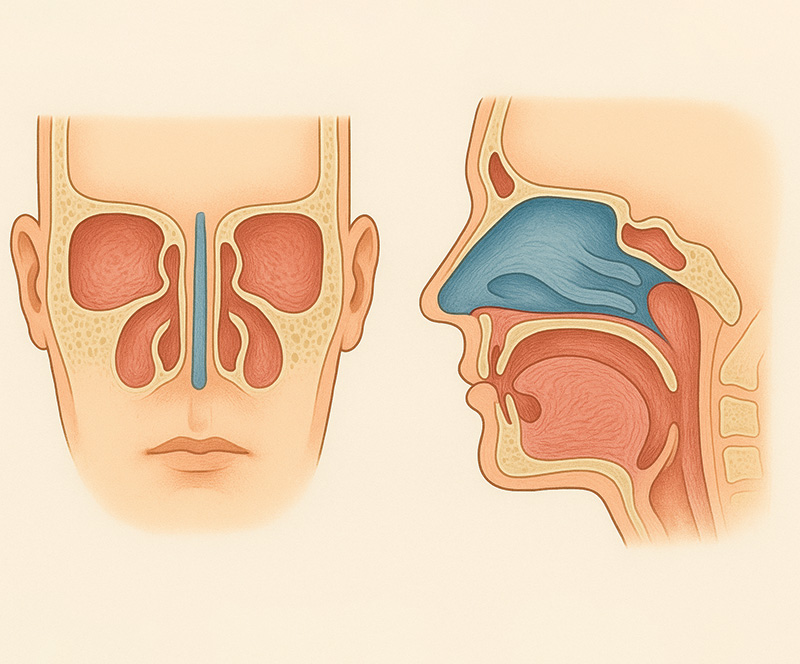Rhinoplasty and the Internal Nose: Breathing Matters

When most people think of a rhinoplasty, they imagine changing the appearance of the nose — making it straighter, smaller, or more refined. But the nose isn’t just for looks. It is the main gateway for breathing, filtering, and conditioning the air we take in with every breath. Because of this, it’s important to understand the internal nose, how it works, and how cosmetic surgery can affect nasal airflow.
The Internal Nose in Simple Terms
Inside your nose are structures that guide and regulate airflow. Think of them like the “plumbing” and “air filters” of your breathing system:
- Nasal septum – the wall of cartilage and bone that divides the nose into right and left sides. A “deviated septum” means it leans one way or the other, which can narrow airflow.
- Turbinates – curved shelves of tissue along the sides of the nasal passages. They warm and humidify the air, but if enlarged (common with allergies), they can block breathing.
- Nasal valves – the narrowest point of the airway. These are critical for unobstructed breathing, but also the most easily compromised during surgery if not addressed properly.
- Mucosa – the moist lining inside the nose that swells when inflamed from allergies, colds, or irritants.
When all of these are balanced, airflow is smooth. When one or more are out of alignment, internal nose breathing can become difficult.
Symptoms of Nasal Breathing Problems
People with internal nasal issues often describe nasal congestion and other struggles:
- Chronic nasal congestion or stuffiness
- Mouth breathing, especially at night
- Snoring or poor sleep
- Trouble exercising due to feeling “air hungry”
- Recurrent sinus infections or headaches
- A sense that “one side of my nose just doesn’t work”
It’s important to recognize that not all nasal symptoms are structural — allergies, colds, or irritants can cause temporary problems, while true anatomic obstructions usually persist.
Medical vs. Surgical Treatments
For many patients, medical treatments are the first step:
- Antihistamines or nasal steroid sprays for allergies
- Saline rinses to flush irritants
- Decongestants for short-term relief
When these measures aren’t enough, surgical treatments may be considered. ENT surgeons often perform septoplasty (to straighten the septum), turbinate reduction, or procedures to support the nasal valves. In many cases, insurance may cover these if breathing problems are significant and documented.
My Focus: Cosmetic Rhinoplasty With Breathing in Mind
In my practice, most patients come to me for cosmetic rhinoplasty — they want a nose that looks natural and balanced on their face. While breathing isn’t usually their main concern, it is always part of my surgical plan.
I’ve developed a straightforward technique that addresses obstructive anatomy when needed, helping patients with mild to moderate breathing compromise breathe better. Just as importantly, my approach is designed to protect the nasal valves and preserve healthy airflow during cosmetic reshaping.
The reality is that rhinoplasty can sometimes compromise breathing if done poorly — but in my practice, this is extremely rare. In fact, many of my patients report improved breathing after surgery.
When to See an ENT Instead
If your main concern is severe breathing problems, such as constant obstruction, long-standing sinus infections, or debilitating sleep issues, an evaluation with an ENT (Ear, Nose & Throat surgeon) is the right place to start. These specialists are trained to manage complex internal nasal and sinus disease and can often work with your insurance to cover medically necessary procedures.
Patients who need more extensive structural support may also benefit from a tailored septorhinoplasty to balance appearance and function.
The Bottom Line
Your nose is both a cosmetic and functional organ. A successful rhinoplasty should make your nose look better without sacrificing its ability to breathe — and ideally, it should enhance both.
If you’re considering rhinoplasty primarily for cosmetic reasons, know that in my practice your breathing is always part of the equation. For those with major functional problems, I encourage collaboration with ENT specialists. The best results come when form and function are respected together. Schedule a consultation with our board-certified plastic surgeon to develop a plan that protects healthy respiration.
Illustration Suggestion
An educational diagram showing:
- The nasal septum (center divider).
- The turbinates along the sides.
- The nasal valve area near the front.
- Airflow arrows (blue) showing how air passes through.
- Labels kept simple (no medical jargon overload).
This type of image helps patients visualize why a “crooked wall” or “swollen filter” can make breathing harder, and how surgery can help.
